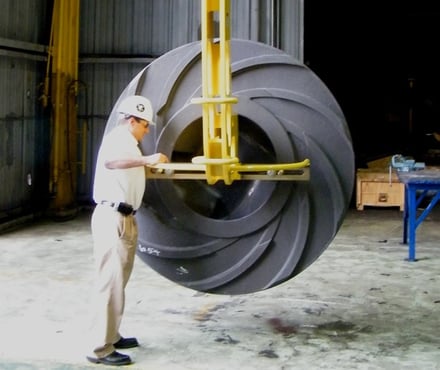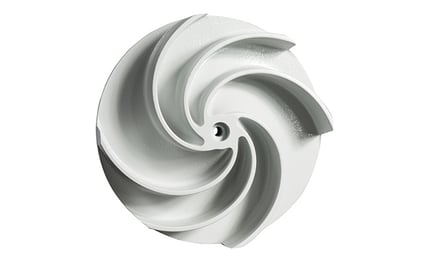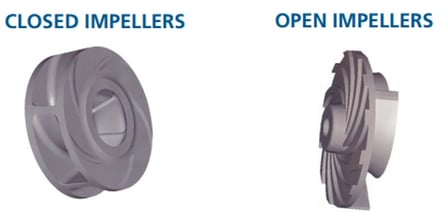
If you’ve spent enough time around slurry pumps, you have probably learned how an impeller vane works, what it does, and when it should be retired from service. But what makes a particular impeller vane the right one for a given application?
The simple answer is there is no such thing as the ideal impeller or vane design. The right design for an application depends on wear resistance, efficiency, slurry character, and other characteristics. There are many types of impeller vane shapes and layouts for different operating conditions; what’s important is understanding how those conditions affect a pump’s performance in the field. Design factors that should be at the top of your consideration list include vane shape, vane angles, vane quantity, and shroud design.
Vane shape
The shape of a vane can affect the direction and magnitude of flow inside the pump as well as overall pump efficiency and wear life.
- Radial flow: These are paddle-wheel shaped vanes that convert axial flow into radial flow (i.e., outward from the center) as the impeller turns. These are simple to manufacture but inefficient in slurry applications.
- Axial flow: These resemble propeller or turbine vanes. In contrast to radial vanes, these vanes do not change the flow direction. They are highly efficient in some applications but are not optimal in slurry pumps as they can wear quickly.
- Mixed flow: These vanes are the most common in GIW slurry pumps; they have a twisted design for optimal effectiveness. They gradually convert flow from axial to radial, and are more efficient than radial vanes and more sturdy than axial vanes.

Vane angles
An impeller has an inlet angle (i.e., a leading edge near the center), an outlet angle (i.e., a trailing edge near the pump wall), and a vane overlap.
- Inlet angle: This is designed for shock-free fluid entry at the pump’s best efficiency point, which improves pump efficiency, reduces wear, and decreases risk of cavitation.
- Outlet angle: Higher outlet angles increase the head at a given speed, at the cost of lower efficiency and wear performance. Lower outlet angles increase efficiency and vane length, at the cost of reduced head and, in some cases, vane clearance. Outlet angles are usually optimized to achieve a balance of these factors.
- Vane overlap: Positive overlap is best for wear performance because it minimizes recirculation. “Turn downs” are common in centrifugal pumps, which trim the vane’s outer diameter. This can reduce vane overlap and length, so they should be limited to about 10% of the vane’s diameter.

Vane quantity
When it comes to vane quantity, more is not always better. More vanes can increase head at a given speed, improve efficiency, and reduce the risk of damage from vane pass. On the other hand, higher vane quantity can reduce the space between vanes, which can cause clogs when processing larger particles. It also requires a higher inlet pressure to prevent cavitation, and reduces possible vane length overall. Most of our slurry pumps use three to five vanes; water pumps often feature six or more.
- Three vanes: This design is optimal when low suction pressure and large sphere pressure are preferred. Wear performance is usually a lower priority in this design.
- Four vanes: This provides a good balance between most factors, including wear performance, vibration, and passage size. Our TBC series of pumps feature four vanes.
- Five vanes: We opt for this design when wear performance is critical, and passage size requirements and available suction pressure are reasonable. The MDX pump, which can be used in cyclone feed applications, uses a five vane design.

Shroud design
Most impellers have at least a single shroud to keep the vanes in the impeller’s disc-shaped central hub.
- Closed shroud: These feature an additional shroud on the suction side of the vane. This design is best for wear performance because the suction inlet helps channel the slurry flow and minimizes recirculation.
- Open shroud: The vanes are exposed on the suction side in this design, which is most common in froth applications or slurries with stringy materials (e.g., roots). Some of our pumps, like the HVF and the LCC, use an open shroud design.

GIW pump designs
Each model in our extensive line of slurry pumps features a robust design built to tackle our customers’ greatest pumping challenges. To showcase the variety of vane layouts, here are some examples of vane selections for three of our most popular pumps:
- MDX: This has a five-vane impeller designed to efficiently transport aggressive slurries. It also features an oversized shroud and extended vanes that work with the slurry diverter to provide sufficient passage clearance. This design also reduces recirculation and grinding wear between the impeller and suction liner.
- HVF: This pump features 10 to 12 vanes and has many of the same parts as the LCC pump. The HVF’s hydraulic design removes air from the impeller eye while the pump is running, making it possible to retrofit the pump to any froth application.
- LCC: The metal LCC pump features a twisted, three-vane impeller, suction plate, and liner of high-chrome white iron. This design is highly efficient and lowers net positive suction head while maximizing sphere passage. Customers can choose a closed or open shroud impeller design according to their application.
There are almost as many vane configurations as there are pump applications, which is why it is so important to understand what goes into designing and selecting impeller vanes. Fortunately, KSB GIW, Inc. sales engineers are ready to help you find a product with the right balance and character for your application.
